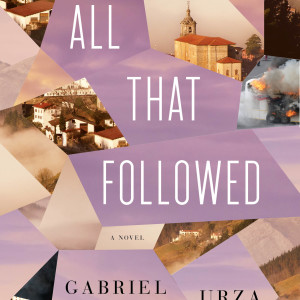In Defense of the Present Tense
It is Everywhere, Including Our Writing
In 2010, the novelist Philip Hensher complained that half of that year’s Man Booker nominees were novels written in the present tense. He insulted the choice, dismissing it as only fashionable. Hensher went so far as to write an op-ed—in the present tense—complaining the present tense was “everywhere, like Japanese Knotweed.” His complaint is at least among the most generous I’ve come across—it acknowledges some historical examples of the present tense like Dickens’s Bleak House, as well as that it is used in both English lyric poetry and the vernacular, as well as in journalism and screenplay treatments. Phillip Pullman did much the same, his op-ed citing the verb tense’s use in Bleak House also, as well as, occasionally, in Jane Eyre. But both men acted as if its use should be, if not abolished, severely curtailed.
Laura Miller, covering the controversy for Salon, writes:
What reason is it that writers give for opting for the present tense? According to Hensher, they’ve been assured by “creative writing tutors” that it will make their writing “more vivid” and immediate. Philip Pullman—author of the bestselling series of young-adult novels “His Dark Materials”—also jumped into the fray in the pages of The Guardian, blaming an aversion to the past tense on the “timorous uncertainty” of “sensitive and artistic storytellers” afraid of the “politically dodgy” implications of seeming to know too much about their own story: “Who are we to say this happened and then that happened? Maybe it didn’t, perhaps we’re wrong, there are other points of view, truth is always provisional, knowledge is always partial, the narrator is always unreliable, and so on.”
You might think that given half the novels on that year’s Booker long list were in the present tense, this could be proof the choice had some merit, but the verb tense was apparently so benighted Laura Miller takes on the role of defending it herself, concluding that the problem is with the writer who uses it, not inherently with the choice itself.
Yes, young writers are prone to believing that techniques “calling attention to” the unreliability of storytelling itself are far more daring, innovative and interesting than they actually are. But like other carped-about trends (minimalism, incest as a plot point, short stories ending in an “epiphany,” etc.), the present tense is only one among any number of crutches clung to by mediocre writers, usually because they’ve seen other, more talented writers use them to advantage. The problem lies less with the tool than with the workman.
* * * *
In my experience, most conversations about the present tense go as follows:
“the present tense”
“complaint”
“good point that some of the writing is good”
“it’s really only good if people use it well”
[awkward silence, no further discussion]
As a part time professional ‘creative writing tutor’, I can say I only ever teach the present tense as one tool among many. I do not urge it on my ‘sensitive and artistic storytellers’, or any of the insensitive ones either. I teach students that verbs are the way they create a relationship for the reader to time, and function a little like the way a horizon line might in a picture. As for using it to dodge the ‘politically dodgy’, well, I can’t imagine teaching anyone that way with a straight face—and so that strikes me as something of a straw man. Or, woman, perhaps. As Laura Miller notes in that same coverage, William Gass wrote in 1987 on what seemed to him to be the alarming increase in the Present Tense suggesting it was in some way related to the increase in women writers. And, yes, of course, writing programs.
Which is to say, these complaints aren’t new. Reading the Gass essay is like finding the source code for so many contemporary complaints about literature (dating, yes, to 28 years ago). He begins with a deliberately bad story told stagily in the present tense—as if performing it badly is a way to prove it doesn’t work—then goes on to praise Katherine Anne Porter’s “Under the Flowering Judas Tree” as a good example. He insists the present tense was rarely used before that year, and is better left that way.
Gass then adds, re: women, “And they hand me a list of a hundred authors each named Ann (or Anne).” And of course, includes a dig at Jay McInerney’s Bright Lights, Big City.
We should pause to offer a little pity to Jay McInerney. To the extent that the anti-present-tense crowd views it as a recent fad, usually the first damning thing they can say about it is that Jay McInerney used it in a novel set in New York’s nightlife scene—a novel that everyone still knows, also. It could be said to have survived this hazing. As for the idea women are responsible for the increase, well, the pity I extend there is toward Gass (who would likely never accept it). He would seem to be aiming at writers like Colette, Anais Nin, Jean Rhys or Marguerite Duras (I’ll let you all decide which Anns he means). But at least part of the popularity of the present tense in 1987 must have come from the work of men also—in particular, writers like Updike, his Rabbit novels all written in the present tense—beginning in 1960—and bestsellers. James Salter’s present tense novel of erotic obsession, A Sport & A Pastime, was published in 1967. These are not obscure examples. And one of my favorite examples includes Gass—who never mentions anything in his essay of his experience of writing his own, much beloved story, “In the Heart of the Heart of the Country,” written in the present tense in 1967—and which was and still is so widely taught, it easily has done as much to spread the use of the present tense as anything else anyone published in the 20th century.
He is oddly sure to fault writing teachers in programs for the spread of the tense, but he also says they are not teaching it—he believes the students are teaching it to each other, not the professors, and blames the professors for this. But either way, this, along with the previous complaints, really begs this question: What exactly are writing professors teaching about the present tense?
* * * *
I approached a number of authors who teach or have taught writing to students at a variety of levels and asked how they taught the present tense. Many said they didn’t, which certainly encourages one theory—that the present tense may be the current preferred mode of the self-taught writer. Regardless, here are a few approaches and theories on usage.
Ann Beattie:
I suspect that it’s used so often, in part, because of things that unfold right before our eyes, or seem to—the obvious example being movies, when something happens, and happens, and continues to happen, until finally it has happened and then the movie ends. The experience of a movie is that you, and the movie, exist in the present tense, and that you are observing what is happening moment-to-moment. Related: what seems to be the writer hanging back and not judging, because there is no time for that if something appears to be happening in the instant. The writer, for better or for worse, is always present in the material (whether you want to call the writer an invisible—or sometimes quite visible—character, or not) but can appear to be just casually noticing what is unfolding, how things are proceeding. Present tense gives the illusion of being hands-off: just tracking, like a camera. (A camera itself, of course, gives the illusion that it records “reality.”) Sometimes it’s a way of pretending the writer is on an equal level with/equal footing with the character(s)—just a bunch of us hangin’ out, moving through “real” time. Or: De-emphasizing drama. If something is going on moment-to-moment and not assessed with a narrative fix or grip on it, the writer is pretending not to know (or truly doesn’t; how various writers create first drafts varies, of course) how things will unfold, so the writer and the reader are at least temporarily aligned, as they are engaged in speculation about the future.
Elizabeth McCracken:
I think a lot of writers choose the present tense as a form of cowardice. They think the present tense is really entirely about the present moment, as though the past and future do not actually exist. But a good present tense is really about texture, not time, and should be as rich and complicated and full of possibilities as the past tense. They too often choose the present tense because they think they can avoid thinking about time, when really it’s all about time. All narrative decisions are more interesting when you think about the mobility they grant you instead of the mobility they restrict.
Heidi Julavits:
Present tense allows us to pretend that action and thought are immediate and concomitant. I think it promotes seemingly objective reportage, of events and of feelings, and allows a person not to “think” or analyze too much what is happening emotionally or otherwise. So present tense can relieve a writer of that burden, if it feels burdensome. But I like my present tenses full of the past, if possible. Not as a flashback, mind you—I like my present tenses to acknowledge that the person in the present tense did not come into existence in this moment, and that a whole world of time exists behind them and props them up, even if it is never directly mentioned.
Jess Row:
I emphasize how present and past tense create completely different kinds of narrative: past tense involves retrospective intelligence and insight, present tense creates a sense of immediacy and what we might call non-insight, a lack of information about what’s next. The narrator’s relationship to the story is completely changed when we move from past to present or vice versa. But if I have enough time, it’s best to fold a discussion of tense into a larger discussion of the elasticity of time in narrative, ranging from almost completely static narratives (as in Robbe-Grillet) to narrative leaps or super-fast transitions, as we see in lots of flash fiction, or David Mitchell, or Alice Munro.
Matt Bell:
What I focus on is less present vs. past, and more the difference between the “time narrated” and the “time of narration.” There’s so much power in modulating that gap and being able to work on both timelines. Present tense of course is one version of that relationship, with the two more or less occurring simultaneously, so we talk about what a narrator loses by narrating in real-time (reflection, perspective, the knowledge of actually telling a story, shaped as such) and also what’s gained (immediacy, certain kinds of useful bewilderment or misunderstanding, etc.) But I also use the present tense as a way of talking about the past, even though the speaker is really telling the story from the present. I think that’s a pretty common tactic, actually. I’m actually doing a similar thing in something I’m working on right now—the reflective present tense, which is the way both memory and trauma often work.
Swati Khurana, an emerging writer, had something closer to data to report from her recent experience as an MFA graduate student teaching an introduction to creative writing class to undergraduates—these courses, increasingly common, give students an introduction to writing poetry, the personal essay and fiction in one semester.
I think because the class started with poetry, people were really open to the present tense, and as most of Creative Nonfiction and Fiction pieces were really short, if they used the present in the different genres, it was only for about three to five pages. I found that almost all in-class prompt-inspired shared writing was in the present, and sometimes if they continued working on it, it would then shift into the past. I also did some POV exercises, where students had to write in You/They/We POVs, and they were also almost in the present tense as well. So in my findings, 1) writing poetry, 2) sharing raw first drafts, and 3) 2nd person and 1st/3rd plural POVs created contexts where my students most often wrote in the present tense. And 4) after I shared some podcasts of The Moth and This American Life, I saw more present tense in the Creative Nonfiction than before.
* * * *
And what is the present tense for? Why use it?
The writer Shelley Salamensky might be speaking of the uncertainty Gass mentioned when she says, “In writing nonfiction, present tense inherently asserts an understanding that this is a step-by-step reconstruction from memory—exploratory, tentative, hypothetical, potentially fallible.” I would say, this implication extends to fiction. Or at least, it can. We can even taxonomize the use in nonfiction, as the writer Donovan Hohn says: “There’s the historical present, there’s the critical present (‘in this photo the mules appear to be eating something, the light suggests that it is midday’). There’s the epistolary or diaristic present—c.f., Matthiessen’s Snow Leopard (‘Sept. 28. At sunrise the small expedition meets beneath a giant fig. . .’).”
And when we get to the diaristic and the epistolary, when in combination with the conversational, we start to understand why we would use it in fiction.
We use it in poetry, journalistic profiles, vernacular stories told between friends, screen treatments, stage directions. In literary criticism, when describing what a writer has done, the writer’s work is treated as a continual present—a place where everything is still happening each time it is read. This resembles the way victims of assault and trauma think of their memories—they almost always tell the story of what happened to them in the present tense, because it is a place still vivid for them, in their minds. It is entirely plausible to imagine any of these being an influence on a writer in search of form or texture. The novelist Christopher Bram, for example, says of it, “I’ve used present tense myself only once, in Father of Frankenstein, but didn’t notice I was doing it until ten pages in. I realized I was using it because it’s the tense of screenplays. That seemed appropriate for a novel about a movie director so I kept using it.”
Given the present tense is also common as the verb tense of the letter and the diary entry, this seems impossible to assert that the speaker on the page is only ever reporting from something as it is happening, and has no time or room to reflect on the page. At the least, to insist that is all that is possible in the present tense strikes me as a misunderstanding. But this is easily one of the most widespread of misunderstandings about the present tense.
I most often use the present tense in personal essays when I am writing about the past—about events anywhere from the recent past to 30, 40 years removed. When I write in the present tense in nonfiction, it’s a kind of withdrawal into all of the available memory and evidence I can find as I look for the shape that might be there. Most certainly, an exploration of the past. In fiction, I use it when I am writing about a character’s past this way—performing their performance of this kind of act of memory. I see the tense as a way to visit a moment as I would visit a place, a way to walk through time as if it has dimensions, time that has been slowed down or even frozen, and in this way, I can consider the moments I describe more deeply than I might have.
In the present tense, you aren’t stuck to the moment—you can go forward and backward in time. In fiction, the demands of the present tense are in some ways the opposite of that exploration of uncertainty—the tense places a demand for the elimination of all other possibilities in the writer’s imagination—this is what happened and is what is still happening whenever this memory returns to this character or whenever this moment matters. Granted, it requires a belief that memory is like a text that cannot change, in the way writing can, once printed, be permanent and collectible. But the best writers play with this, say, as in Margaret Atwood’s Cat’s Eye, where she moves from the past tense recollections of an adult painter returned to her hometown to the present tense narrative of the child that painter was—and the subject is soon what she has chosen to remember and what to forget—and this is given to the reader, not to the narrator, to discover.
When I move from first to third person, or second, if I keep the present tense, it is not because what happens is somehow cinematic to me—it is perhaps closer to say that cinema most resembles what that looks like. If anything, it feels most like theater to me. But certainly, cinema is an influence on writers. John Updike, in his Paris Review interview, said, of his decision to set Rabbit, Run in the present tense,
Rabbit, Run was subtitled originally, “A Movie.” The present tense was in part meant to be an equivalent of the cinematic mode of narration. The opening bit of the boys playing basketball was visualized to be taking place under the titles and credits. This doesn’t mean, though, that I really wanted to write for the movies. It meant I wanted to make a movie. I could come closer by writing it in my own book than by attempting to get through to Hollywood.
I think we use the present tense, when we do, because it is all around us, and to the extent the modernist imperative, of including the vernacular in fiction, still matters, this may be part of why it is there as a tool.
Does it provide immediacy? Maybe. But I think it does not automatically ensure immediacy any more than the past tense can ensure authority. I think we choose it intuitively because of any or all of those reasons. At the very least, perhaps it is at least time to stop saying it is new, or trendy, and admit that it is here, and has been, for some time. Denying the present tense is valid as a tool would seem only to contribute to its misuse. Which is really, it seems, what everyone who complains of it complains of.




















